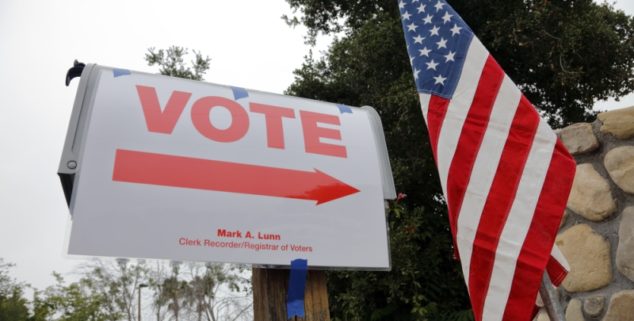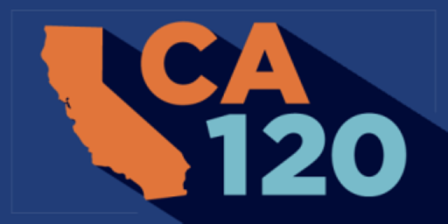News
CA120: A deep dive into voter registration
 A sign designating a polling place during the 2016 election in Ventura County. (Photo: Joseph Sohm, via Shutterstock)
A sign designating a polling place during the 2016 election in Ventura County. (Photo: Joseph Sohm, via Shutterstock)Last week the Sacramento Bee ran a story of voter registration and how the type of registration, and timing of it, can provide a hint about if a voter will participate in an upcoming election. And, if a voter does turnout, if it will be a one-time exercise, or they will be a more permanent voter.
The finding was a good overview of something we have also seen in the data: Voters who register right before an election are more likely to vote in that contest, but they are also less likely to vote in subsequent elections.
Why is this? The authors believe it is because people are registering to vote for a specific candidate or issue, and once that candidate or issue isn’t on the ballot in a subsequent election, they lose interest.
But using historic voter data from Political Data Inc. we can dig even deeper.
Here is what we’ve found:
–Voters who register right before an election are more likely to vote than those who register in the middle of an off-election year or other random date. Those who register online right before an election are even more likely to vote. We can dig deeper and see that those who registered online on the day of one of the 2016 presidential election debates, or on the day of one of the major primary state contests (especially Super Tuesday), turned out in even higher numbers.
–Voters who register right before an election and participate in that first contest are more likely to vote in future contests than non-voters, but those who are re-registrants and vote have the highest turnout. This seems to be largely driven by those who register to vote right before an election: younger people, renters, college students. Someone who has lived in the same house for 20 years isn’t procrastinating and then registering to vote right before an election — and those are the highest turnout voters.
–Targeting voters based on when they registered to vote and how they did it — paper forms, online, Department of Motor Vehicles, or other — can actually make for more cost-effective voter contact and helps separate the most likely voters from the least likely.
We also see this getting more complicated going forward.
Campaigns will segment newly registered voters without any prior vote history and treat them like a “Get Out the Vote” universe.
Thanks to the state’s new automatic registration at the DMV, we now have millions of voters registering or re-registering every year, which is more than we used to see before a presidential election. Also, there hundreds of thousands of voters who are being automatically re-registered without even going to the DMV if they fill out a National Change of Address (NCOA) form.
In today’s voter data environment, campaigns can actually use this information to target voters. For example, there are identifiers for those who were previous registrants, and whether they registered through an active means (online, filling out a form) or through a passive means (DMV or automatic NCOA registration). This is nerdy, but it is incredibly important for a modern campaign that is trying to most efficiently communicate with the right voters.
When building targeting, campaigns will segment newly registered voters without any prior vote history and treat them like a “Get out the vote” universe. If those voters are demographically, politically or regionally likely to support a candidate or cause, then campaigns will use door-knocking, texting, phone calls and other grassroots efforts to try and mobilize them into participating.
But another group — those who are new registrants but with prior vote history, also known as “re-registrants” — don’t need the additional push to get out the door and vote, or mail back their ballot. These voters are highly likely to vote on their own, and campaigns can focus on the persuasion part of their campaign, using mailers, targeted digital ads, etc…
“Active registrations” are the categories of registrations that take some forethought and action on behalf of the voter.
And this targeting can get even deeper with campaigns having access to identifiers — known as “flags “– showing that someone registered via passive or active registration methods. This differentiates that kind of registration that someone goes out and seeks, and then acts on, versus one that is done automatically or without the voter having to seek it out.
The new campaign lingo breaks these into passive and active registrations.
“Passive registrations” include the DMV registrants who have to opt out to not be registered when they are performing a DMV transaction and NCOA registrations. As we have seen (and wrote about in Capitol Weekly) since the automatic registration law was implemented in May of 2018, many voters weren’t even aware they were being re-registered and many voters were even moved into being registered as No Party Preference without their realizing it.
There are also the NCOA registrations which, similarly, are often done in the background. If a voter moves, the secretary of state’s office will send to the county a notice to re-register a voter if they have a perfect match. If the match is imperfect, they will have the county verify it first before re-registering. There are hundreds of thousands of these re-registrations, yet most people, even most political consultants and candidates, don’t realize it is happening.
We have seen big payoffs for campaigns that realize all the valuable data at their fingertips.
“Active registrations” are the categories of registrations that take some forethought and action on behalf of the voter. These voters actually went out of their way, either online or by going to find a paper form and mailing it in. By showing that they are taking active steps to register they are signaling that it matters to them and we have seen higher turnout from these voters.
Of course, by using the voter data systems campaigns can also create their specific targets like selecting all active registrations that happened on the night of the Democratic debates (probably engaged, interested voters), or all passive registrations of 19-to-23 year-old voters in Berkeley and Davis in September (likely college students moving back to school), or 24-to-30 year-old passive re-registrations in June and July in homes with older voters (potentially kids moving back home after college).
Some of this is just fun to watch and engaging for researchers. But we have also seen big payoffs for campaigns that realize all the valuable data at their fingertips, and how to use targeting to make the most of their campaign expenditures. Maybe a campaign sends an email to every new passive registration that looks like a college student, or sends a text to every voter who actively registered on the night of one of the Democratic debates.
In today’s data rich environment, with campaigns getting bigger and more costly and with a growing voter file and more methods of registering, these targeting options are becoming the basic elements of a successful campaign.
—
Editor’s Note: Paul Mitchell, a regular contributor to Capitol Weekly, is the creator of the CA120 column, vice president of Political Data Inc., and owner of Redistricting Partners, a political strategy firm.
Want to see more stories like this? Sign up for The Roundup, the free daily newsletter about California politics from the editors of Capitol Weekly. Stay up to date on the news you need to know.
Sign up below, then look for a confirmation email in your inbox.

Leave a Reply